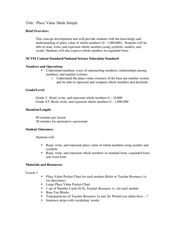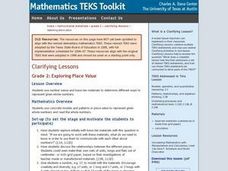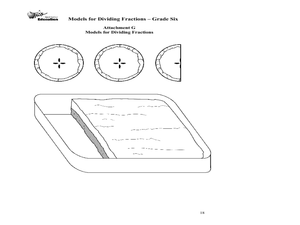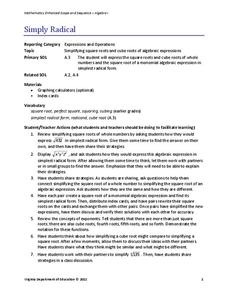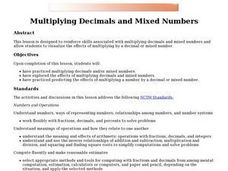Curated OER
Simple Machines III - Pulleys
The principles behind pulleys, levers, and simple machines are the focus of a science lesson plan. In it, learners take part in a whole-class activity. There are two groups of pupils who each must lift objects with fixed pulleys and...
Curated OER
Cards to 24
Third graders practice with a deck of cards to play a version of the math game 24. They use four cards and combinations of the four arithmetic operations to try to make a total of 24. Each student writes and solves problems which...
Curated OER
Decimals in the Dugout
Students investigate place value and decimals during baseball related activities. For this place value lesson, students explore place value with decimals. Resources are included.
Curated OER
Let's Trade
Second graders engage in a lesson plan which focuses on adding two-digit numbers and the regrouping process. They identify when the regrouping process is necessary and make appropriate "trades" to complete an addition problem.
Curated OER
Just the Facts! Exploring Order of Operations and Properties of Real Numbers
Sixth graders explore the concept of order of operations. In this order of operations lesson, 6th graders view a powerpoint about order of operations in society. Students post on a blog about order of operations.
Curated OER
Division: Three Digit by Two Digit
In this division problem, students solve for the quotients in 24 three digit by two digit division problems. They use the long division method to find each quotient.
Curated OER
Sets and the Venn Diagram
Students review number sets and complete a Venn Diagram for number sets. In this number sets lesson, students review integers, whole numbers, and elements. Students use computers to create a Venn Diagram for number sets. Students...
Curated OER
Single Step Operations
In this math operations worksheet, students solve the math story problems by solving single step operations. There are 10 problems on this worksheet and the answers are on the second page.
Curated OER
How the West Was One - Three x Four
While this lesson provides a motivating and interesting way to review the concept of the order of operations, it involves the use of software called How the West Was One + Three x Four. There are also other resources that are referenced,...
Curated OER
Related Addition and Subtraction
These fact families need more members! Here are 10 addition and subtraction problems that need related facts written in. There are single and double-digit numbers, and each of these is written out in a sentence. Note that the grammar is...
Curated OER
Place Value Made Simple
Elementary schoolers explore place value to the millions place. They construct and evaluate the value of numbers. Working in small groups, pupils problem solve with pocket place value charts, and examine standard and expanded forms. This...
Curated OER
Grade 2: Exploring Place Value
Creative problem solving is fun and helps kids conceptualize content. They use grid paper, manilla paper, and markers to cut, draw, and show given double-digit numbers as many ways as they can.
California Education Partners
Lashelles Garden
Let knowledge grow bountifully like plants in a garden. Given a diagram of a rectangular garden split into plots, scholars determine the area of the entire garden and the areas of the individual plots. As a culminating activity, they...
Curated OER
Place Value and Rounding
Use rounding mountains and number lines to learn how to round numbers and learn place value. Learners will use a worksheet to help them round numbers. They will play a game called "Place Value Match-up" to help with skill practice. All...
Inside Mathematics
Rugs
The class braids irrational numbers, Pythagoras, and perimeter together. The mini-assessment requires scholars to use irrational numbers and the Pythagorean Theorem to find perimeters of rugs. The rugs are rectangular, triangular,...
Curated OER
Investigation - Who is Right?
Third graders investigate two mathematic scenarios and determine which is correct. They compare adding columns and places (such as the tens place, hundreds place, and so on) and familiarize themselves with how to add larger numbers.
Curated OER
It Has Been Rubbish For Years
Students are presented with the problems of percentages and focus upon numbers in contrast to 100. They calculate problems with money and are engaged with the use of games as a teaching tool. Students also interpret data as presented in...
Curated OER
Multiplying and Dividing Decimals
Learn to multiply with decimals. The class reviews multiplying multi-digit whole numbers based off of word problems. Then they learn how to multiply using decimals and practice with money problems.
Ohio Department of Education
Models for Dividing Fractions - Grade Six
Fifth and sixth graders use food and candy to help them represent division of fractions and develop algorithms to solve fraction problems. They discuss dividing whole numbers by fractions. Pupils use sticks and chocolate bars to...
Virginia Department of Education
Simply Radical
Simplifying is radical, dude! After reviewing how to simplify square roots of whole numbers, scholars consider how to simplify square roots of algebraic monomials. Also taken under consideration is how to simplify cube roots of whole...
Curated OER
Extreme Elevations
Seventh graders use highest and lowest points of land elevation around the world to find the differences. Sea level is zero, so students be operating with positive and negative numbers. After students find the information on the...
Curated OER
Inferring Character Traits
Here is a lesson which is "flexible," and can operate as an individual or whole class activity. After reading a book of their choosing, with the use of a semantic map, learners identify character traits. They infer how their feelings...
Curated OER
Numbers and Operations- 24
Students construct number sentences. In this computation lesson, students participate in a game using four numbers to make the number 24.
Curated OER
Multiplying Decimals and Mixed Numbers
Young scholars multiply decimals and/or mixed numbers. They explore the effects of multiplying decimals and mixed numbers. They practice estimating answers when a number is multiplied by a decimal or mixed number.












